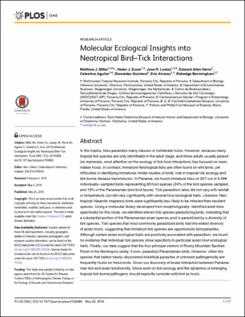| dc.contributor.author | Miller1, Matthew J. | |
| dc.contributor.author | Loaiza, Jose R. | |
| dc.contributor.author | Herre, Edward Allen | |
| dc.contributor.author | Aguilar, Celestino | |
| dc.contributor.author | Quintero, Diomedes | |
| dc.contributor.author | Alvarez, Eric | |
| dc.contributor.author | Bermingham, Eldredge | |
| dc.contributor.author | Esser, Helen J. | |
| dc.date.accessioned | 2020-07-07T06:03:47Z | |
| dc.date.available | 2020-07-07T06:03:47Z | |
| dc.date.issued | 2016-05-20 | |
| dc.identifier.other | https://doi.org/10.1371/journal.pone.0155989 | |
| dc.identifier.uri | http://repositorio-indicasat.org.pa/handle/123456789/178 | |
| dc.description | In the tropics, ticks parasitize many classes of vertebrate hosts. However, because many tropical tick species are only identifiable in the adult stage, and these adults usually parasitize mammals, most attention on the ecology of tick-host interactions has focused on mammalian hosts. In contrast, immature Neotropical ticks are often found on wild birds, yet difficulties in identifying immatures hinder studies of birds’ role in tropical tick ecology and tick-borne disease transmission. In Panama, we found immature ticks on 227 out of 3,498 individually–sampled birds representing 93 host species (24% of the bird species sampled, and 13% of the Panamanian land bird fauna). Tick parasitism rates did not vary with rainfall or temperature, but did vary significantly with several host ecological traits. Likewise, Neotropical–Nearctic migratory birds were significantly less likely to be infested than resident species. Using a molecular library developed from morphologically–identified adult ticks specifically for this study, we identified eleven tick species parasitizing birds, indicating that a substantial portion of the Panamanian avian species pool is parasitized by a diversity of tick species. Tick species that most commonly parasitized birds had the widest diversity of avian hosts, suggesting that immature tick species are opportunistic bird parasites. Although certain avian ecological traits are positively associated with parasitism, we found no evidence that individual tick species show specificity to particular avian host ecological traits. Finally, our data suggest that the four principal vectors of Rocky Mountain Spotted Fever in the Neotropics rarely, if ever, parasitize Panamanian birds. However, other tick species that harbor newly–discovered rickettsial parasites of unknown pathogenicity are frequently found on these birds. Given our discovery of broad interaction between Panamanian tick and avian biodiversity, future work on tick ecology and the dynamics of emerging tropical tick-borne pathogens should explicitly consider wild bird as hosts. | en_US |
| dc.description.abstract | In the tropics, ticks parasitize many classes of vertebrate hosts. However, because many tropical tick species are only identifiable in the adult stage, and these adults usually parasitize mammals, most attention on the ecology of tick-host interactions has focused on mammalian hosts. In contrast, immature Neotropical ticks are often found on wild birds, yet difficulties in identifying immatures hinder studies of birds’ role in tropical tick ecology and tick-borne disease transmission. In Panama, we found immature ticks on 227 out of 3,498 individually–sampled birds representing 93 host species (24% of the bird species sampled, and 13% of the Panamanian land bird fauna). Tick parasitism rates did not vary with rainfall or temperature, but did vary significantly with several host ecological traits. Likewise, Neotropical–Nearctic migratory birds were significantly less likely to be infested than resident species. Using a molecular library developed from morphologically–identified adult ticks specifically for this study, we identified eleven tick species parasitizing birds, indicating that a substantial portion of the Panamanian avian species pool is parasitized by a diversity of tick species. Tick species that most commonly parasitized birds had the widest diversity of avian hosts, suggesting that immature tick species are opportunistic bird parasites. Although certain avian ecological traits are positively associated with parasitism, we found no evidence that individual tick species show specificity to particular avian host ecological traits. Finally, our data suggest that the four principal vectors of Rocky Mountain Spotted Fever in the Neotropics rarely, if ever, parasitize Panamanian birds. However, other tick species that harbor newly–discovered rickettsial parasites of unknown pathogenicity are frequently found on these birds. Given our discovery of broad interaction between Panamanian tick and avian biodiversity, future work on tick ecology and the dynamics of emerging tropical tick-borne pathogens should explicitly consider wild bird as hosts. | en_US |
| dc.language.iso | eng | en_US |
| dc.rights | info:eu-repo/semantics/openAccess | |
| dc.rights | https://creativecommons.org/licenses/by-nc-sa/4.0/ | |
| dc.subject | Molecular Ecological | en_US |
| dc.subject | Insights into Neotropical | en_US |
| dc.subject | Bird–Tick | en_US |
| dc.subject | Interactions | en_US |
| dc.title | Molecular Ecological Insights into Neotropical Bird–Tick Interactions | en_US |
| dc.type | info:eu-repo/semantics/article | en_US |
| dc.type | info:eu-repo/semantics/publishedVersion | |

